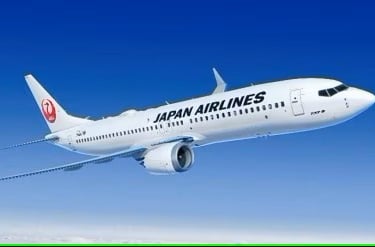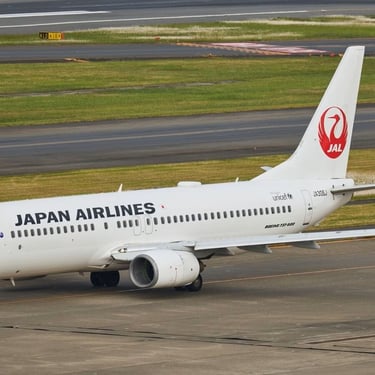japan airlines boeing 737
The Boeing 737-130 is recognized as a pivotal milestone in aviation history, being the inaugural model in what would evolve into one of the most
Sunnynithi
7/3/20254 min read
The Boeing 737-130 is recognized as a pivotal milestone in aviation history, being the inaugural model in what would evolve into one of the most prolific families of commercial airliners worldwide. Presently, this significant aircraft is showcased at The Museum of Flight in Seattle, symbolizing both aviation progress and the lasting impact of the Boeing 737 series.
The Emergence of an Aviation Icon
The aircraft housed in the museum is the original 737 ever constructed. It marked the end of a production era at Boeing Plant 2. Pilots Brien Wygle and Lew Wallick conducted its first flight on April 9, 1967. This momentous initial flight signified the start of what would become one of the most vital aircraft families in commercial aviation.
The Boeing 737-100 ascended into the skies for the first time 57 years ago on April 9, 1967. That first flight was the culmination of extensive planning and development, as Boeing had been investigating designs for short-haul jet aircraft and recognized a demand for a new plane to complement the 727 on shorter, less busy routes.
From Experimental Aircraft to Museum Icon
Boeing utilized the 737 as a testing vehicle before it transferred ownership to NASA, where it made significant contributions to aviation research. NASA acquired this initial airframe for research purposes, aiding in the advancement of fly-by-wire technology. Now preserved at the Museum of Flight, it stands as a beacon of aviation progress.
The transition of the Boeing 737-130 from a test aircraft to a museum exhibit highlights the growth of aviation technology. After fulfilling Boeing's testing requirements, it went on to support aviation innovation through NASA's research initiatives, playing a role in developing technologies beneficial to future aircraft models.
Why the Boeing 737 Series Became So Popular
The Boeing 737 family's success stems from several key factors:
Operational Efficiency
Reliable and cost-effective, the 737 series boasts a... established reputation that has attracted airlines globally. Its design philosophy emphasizes durability, fuel efficiency, and straightforward maintenance – characteristics that airlines hold in high regard.
Adaptability and Growth
The 737 family has undergone consistent evolution to keep pace with shifting market needs. Following collaboration with prospective clients, the 737 Next Generation (NG) initiative was unveiled on November 17, 1993. This ability to adapt and enhance has allowed the aircraft to remain pertinent over several decades.
Global Presence
The 737's flexibility has rendered it appropriate for diverse markets and route frameworks, ranging from brief domestic flights to medium-haul international journeys. This adaptability has played a key role in its extensive adoption around the world.
Japan's Long-standing Connection with the Boeing 737
Japan has served as an important market for the Boeing 737 family, with numerous Japanese airlines utilizing various aircraft models:
Japan Airlines (JAL)
JAL Express was founded in April 1997, featuring Boeing 737 aircraft. This subsidiary airline operated the 737 on domestic and regional routes, illustrating the aircraft's suitability for Japan's aviation landscape.
In contrast to earlier models of the B737, the most notable upgrades besides increased fuel capacity and improved aerodynamic features are the large blended winglets installed at the wingtips on JAL's Boeing 737-800 fleet, highlighting the ongoing enhancements within the aircraft family.
Prospective Growth
Japan Airlines is set to receive its first Boeing 737 MAX aircraft in 2026, with the aircraft type "decreasing both fuel consumption and carbon emissions by 15% compared to the planes the airline is replacing," as per Boeing's statement. This reflects Japan's continued trust in the 737 family for future operations.
Experiencing the Museum
At The Museum of Flight, guests can discover the Boeing 737-130 and appreciate its importance in aviation history. Step aboard a US Air Boeing 737 and unwind in business class—make sure to watch the onboard videos and see the actual cockpit up close. This interactive experience enables visitors to value the aircraft's design and grasp why it became so successful.
Japan's Aviation Museums and the 737 Legacy
Japan's admiration for aviation history goes beyond merely operating the aircraft. Visitors can interact with the Boeing 737-MAX and Boeing 777 flight simulators and feel the thrill of being a genuine pilot at Japan's Museum of Aeronautical Science, where they can gain practical experience with 737 technology.
A Lasting Influence
The Boeing 737-130 at The Museum of Flight signifies more than just the inaugural aircraft in a prosperous family – it represents the innovation, engineering brilliance, and forward-thinking mindset that has influenced contemporary aviation. From its landmark first flight in 1967 to its present role as a museum exhibit, this aircraft narrates the tale of how a single design idea evolved into a global aviation phenomenon.
The 737's appeal in Japan and across the globe showcases the aircraft's lasting popularity and effectiveness. As airlines continue to utilize more recent variants like the 737 MAX, the original 737-130 stands as a reminder of the beginnings – a tribute to the visionaries who aspired to make air travel more accessible and efficient. Today, as visitors walk through The Museum of Flight and see this historic aircraft, they're not just looking at a piece of metal and machinery – they're witnessing the birth of modern short-haul aviation and the beginning of a legacy that continues to connect people and places around the world.
Conclusion
The conservation of the Boeing 737-130 at The Museum of Flight guarantees that future audiences can recognize this significant chapter in aviation history. Its journey – from its inaugural flight to becoming a museum display – reflects the growth of commercial aviation itself. As Japan and other nations continue to depend on the 737 family for their aviation requirements, this iconic first aircraft symbolizes innovation, dependability, and humanity's aspiration to fly. The appeal of the 737 series in Japan and around the globe is not solely determined by figures – it represents an aircraft family that has reliably fulfilled its promises of efficiency, dependability, and passenger comfort. The Boeing 737-130 may have marked the beginning, but it established the benchmark for all that came after.
Boeing 737-130: The Pioneering Aircraft That Transformed Aviation


Explore knowledge, trends, and updates for growth.
Connect
sunnynithi@enlightment.me
© 2025. All rights reserved.
Links
Dramas


Follow us